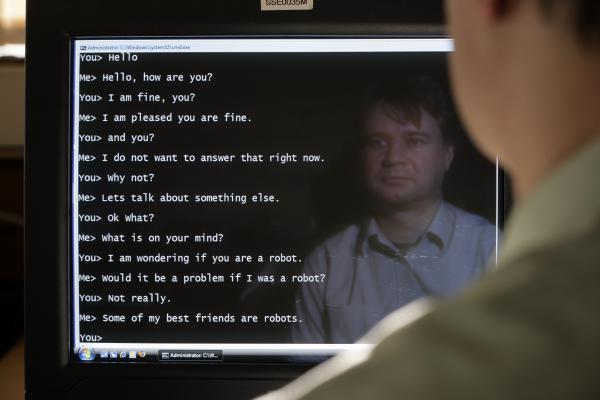At a major Artificial Intelligence competition at the University of Reading on 12 October, machines have come close to imitating human communication.
As part of the 18th Loebner Prize, all of the artificial conversational entities (ACEs) competing to pass the Turing Test have managed to fool at least one of their human interrogators that they were in fact communicating with a human rather than a machine. One of the ACEs, the eventual winner of the 2008 Loebner Prize, got even closer to the 30% Turing Test threshold set by 20th-century British mathematician, Alan Turing in 1950, by fooling 25% of human interrogators.
Top machines from around the world were entered into the competition and following extensive scrutiny these were whittled down to the five best for the 12 October finale. During the Turing Test at the University of Reading, the ACEs competed in a series of five minute long, unrestricted conversations with human interrogators, attempting to pass themselves off as human. The interrogators did not know whether they were conversing with a human or a machine during the test.

Alan Turing first devised the imitation game known as the Turing Test in 1950. In his seminal paper “Computing, Machinery & Intelligence”, he postulated that, “If, during text-based conversation, a machine is indistinguishable from a human, then it could be said to be 'thinking' and, therefore, could be attributed with intelligence”.¹
Organiser of the Turing Test, Professor Kevin Warwick from the University of Reading’s School of Systems Engineering, said: “This has been a very exciting day with two of the machines getting very close to passing the Turing Test for the first time. In hosting the competition here, we wanted to raise the bar in Artificial Intelligence and although the machines aren’t yet good enough to fool all of the people all of the time, they are certainly at the stage of fooling some of the people some of the time.
“Today’s results actually show a more complex story than a straight pass or fail by one machine. Where the machines were identified correctly by the human interrogators as machines, the conversational abilities of each machine was scored at 80 and 90%.² This demonstrates how close machines are getting to reaching the milestone of communicating with us in a way in which we are comfortable. That eventual day will herald a new phase in our relationship with machines, bringing closer the time in which robots start to play an active role in our daily lives”
The programme Elbot, created by Fred Roberts was named as the best machine in the 18th Loebner Prize competition and was awarded the $3000 Loebner Bronze Award, by competition sponsor Hugh Loebner³.
NOTES:
¹The Turing Test held at the University of Reading has followed the original test as outlined by Alan Turing in 1950. Under the official criteria of the Turing Test, a machine that fools more than 30% of the human interrogators is deemed to have passed the test.
² Each of the machines identified as a machine by human interrogators received at least one 80-90% conversational ability score
³The Loebner Prize is awarded by Hugh Loebner, Sponsor of the annual Loebner Prize for Artificial Intelligence.
By training, American scientist Hugh Loebner, sponsor of the annual Loebner Prize for Artificial Intelligence is a sociologist with an interest in methodology and mathematical sociology. Fascinated by Alan Turing's imitation game, and considering creating a system himself to pass it, Loebner realised that even if he were to succeed in developing a computer that could pass Turing's Test, no avenue existed in which to prove it. In his letter of December 30, 1988 to Dr. Robert Epstein, Loebner authorized Dr. Epstein to move forward with a contest, and referring to the Turing Test, Loebner wrote: "Robert, in years to come, there may be richer prizes, and more prestigious contests, but gads, this will always be the oldest." Establishing the Loebner Prize, he introduced the Turing Test to a wider public, and stimulated interest in this science. It remains Hugh Loebner’s desire to advance AI, and for the Turing Test to serve as a tool to measure the state of the art:
The Loebner Prize has awards for three levels of proof, including a prize, the Bronze Award, for the best machine under conditions of the ‘restricted’ level of proof, persuading a human in five minutes that they are not communicating with a machine but a human.
Full criteria - http://www.loebner.net/Prizef/loebner-prize.html
ELBOT – Developer: Fred Roberts (USA – based in Germany)
http://www.elbot.com
Fred Roberts is an American living and working in Germany since 1987. He has a degree in computer science (1984) from Northern Kentucky University, ten years of experience as a software engineer at IBM in USA and Nixdorf in Germany. In 1999 he earned a German degree in psychology at Bielefeld University and began looking for a niche that would combine the two seemingly opposite fields: psychology and computer science. The opportunity came at Kiwilogic (now Artificial-Solutions.com) in 2000 with their commercial software application for the development of virtual dialogue assistants. Aside from various commercial applications one of his projects has been Elbot.com, whose purpose was to converse with users about any topic under the sun, rather than a specialized and self-contained set of FAQs as is usually the demand for commercial systems. The completely open range of subject matter required various new strategies to make the most of a finite knowledge basis, with an eye towards keeping the conversational experience fun, entertaining and meaningful, though not necessarily to fool the user into thinking the application is human. Elbot’s personality is quite clearly that of a robot.




Comments